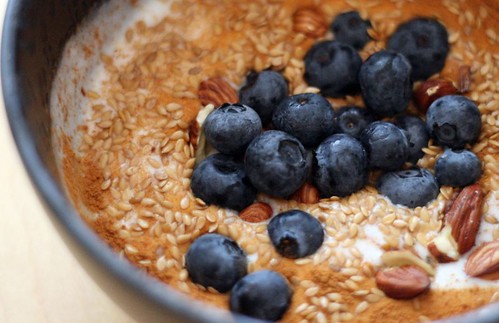Blood Test Analysis: The Cholesterol and Saturated Fat Issue Revisited
I just got my yearly blood test results back last week. I would've liked to have had a much larger blood panel done, but healthcare being what it is, I had to settle for two tests: a vitamin D test and a cholesterol test.
This post is a report on my cholesterol levels and how they differ from the results of the previous blood test. Possible explanations for the changes are also discussed.
My old cholesterol levels
If you're a long-time follower of this blog, you may remember my high-fat diet experiment from a year and a half ago. Part of the idea behind the experiment was to see whether eating a diet high in fat (especially saturated fat) is bad for cholesterol. My cholesterol levels after the experiment were as follows:
LDL: 3 mmol/l (117 mg/dl)
HDL: 2.24 mmol/l (87.36 mg/dl)
Total: 5.7 mmol/l (222.3 mg/dl)
Triglycerides: 0.92 mmol/l (81.88 mg/dl)
For a more thorough summary of the experiment and its results, see this post. In any case, I was quite pleased with my cholesterol levels, despite the fact that official recommendations consider my total cholesterol to be a bit too high.
My current cholesterol levels
So how do the old levels compare with the new ones? Here's the data from the most recent blood test:
LDL: 2.4 mmol/l (93.6 mg/dl)
HDL: 2.67 mmol/l (104 mg/dl)
Total: 5.7 mmol/l (222.3 mg/dl)
Triglycerides: 1.5 mmol/l (133.5 mg/dl)
As you can see, total cholesterol has remained the same, but the ratio of LDL to HDL (which is much more important for health than total cholesterol) has improved from 1.34 to 0.9 – that is, HDL is actually higher than LDL.
Triglycerides have increased, which is bad of course, but I suspect this is due to a two-week drinking binge right before the measurement. Low-carb diets lead to lower triglyceride levels, and since my cholesterol levels in general had improved, this is the only explanation I can think of. Apparently even moderate alcohol consumption can lead to large changes in triglyceride levels (link). I probably should've had the blood test before my holiday instead of after it.
Dietary changes I've made
So what is the explanation behind this improved LDL/HDL ratio? Compared to my diet during the high-fat experiment, I've made the following changes:
- Less cream
- Less butter
- Less yoghurt
- Less cheese
+ More dark chocolate
+ More coconut milk
+ More red palm oil
+ More green tea
Even though I ended the experiment, my fat intake on a typical day is still very high. I also get a lot of saturated fat from chocolate, coconut milk, red palm oil and meat – so much that according to official standards I should probably be dead by now from all the "artery-clogging harmful fats". Thus, while I have gotten rid of much of the dairy I was consuming before, most of the fat I eat is still saturated, and fat is still the main constituent of my diet.
Other changes in lifestyle
In addition to these dietary changes, I've started taking vitamin D3 (2,000 IU daily for a few months, then 5,000 IU) and a multivitamin (2 capsules of Ortho-Core daily) regularly. I've also tried various other supplements, but most of the experiments have likely been too short to have had any effect on cholesterol. In addition, my exercise routine has shifted somewhat from resistance training to aerobic training (i.e. less gym and more running), but I doubt this would have much effect either.
And then there's of course intermittent fasting, which is one of the longest-running experiments on this blog. For the past few weeks I've been skipping breakfast and lunch, but before that, I was eating for 24 hours and then fasting for 24 hours. There is one study that suggested eating only one large meal instead of three smaller ones could be bad for cholesterol, but as I wrote in the post, there were some problems with this study. My hunch is that periods of fasting are either neutral or good for cholesterol.
Conclusion
Continuing to eat a diet high in fat, especially saturated fat, has improved my ratio of LDL to HDL. Though I don't believe the matter is as simple as labeling one "good cholesterol" and the other "bad cholesterol", I do think the ratio is a much better indicator of health risk than total cholesterol. In particular, high HDL appears to be very good, while the potential unhealthiness of LDL depends on the size of the LDL particles.
My diet is in stark contrast to official recommendations, which promote polyunsaturated fats and discourage the consumption of saturated fats and meat. As I've written before, the science does not appear to support the hopelessly outdated official position on fats and cholesterol. The pamphlet I got with my results actually warns never to eat coconut or organ meats but to eat as much candy as you want!
At least in my case, going against the grain has not resulted in any health problems – on the contrary, a higher HDL than LDL is a very good sign. Until I see clinical studies that show saturated fats are harmful, I'm not planning on making huge changes to my diet.
For more information on cholesterol and diet, see these posts:
Coconut Lowers LDL, VLDL and Triglycerides, Raises HDL
How Does Fructose Affect Triglyceride and Cholesterol Levels?
Niacin Raises HDL, Lowers LDL, VLDL & Triglycerides
Low-Carb vs. Low-Fat: Effects on Weight Loss and Cholesterol in Overweight Men
Read More......














